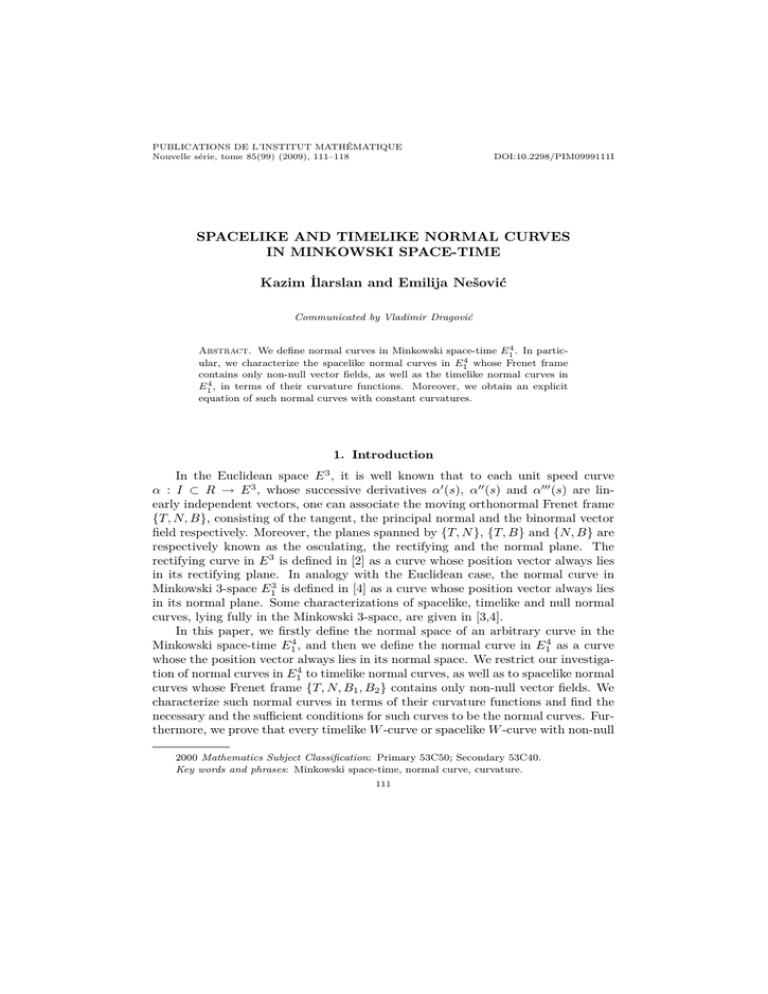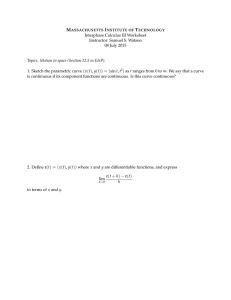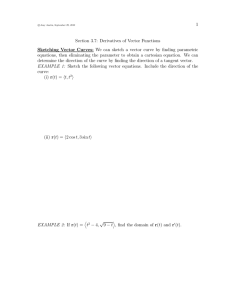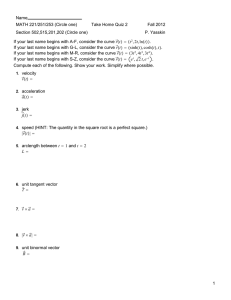PUBLICATIONS DE L’INSTITUT MATHÉMATIQUE Nouvelle série, tome 85(99) (2009), 111–118 DOI:10.2298/PIM0999111I
advertisement

PUBLICATIONS DE L’INSTITUT MATHÉMATIQUE
Nouvelle série, tome 85(99) (2009), 111–118
DOI:10.2298/PIM0999111I
SPACELIKE AND TIMELIKE NORMAL CURVES
IN MINKOWSKI SPACE-TIME
Kazim İlarslan and Emilija Nešović
Communicated by Vladimir Dragović
Abstract. We define normal curves in Minkowski space-time 𝐸14 . In particular, we characterize the spacelike normal curves in 𝐸14 whose Frenet frame
contains only non-null vector fields, as well as the timelike normal curves in
𝐸14 , in terms of their curvature functions. Moreover, we obtain an explicit
equation of such normal curves with constant curvatures.
1. Introduction
3
In the Euclidean space 𝐸 , it is well known that to each unit speed curve
𝛼 : 𝐼 ⊂ 𝑅 → 𝐸 3 , whose successive derivatives 𝛼′ (𝑠), 𝛼′′ (𝑠) and 𝛼′′′ (𝑠) are linearly independent vectors, one can associate the moving orthonormal Frenet frame
{𝑇, 𝑁, 𝐵}, consisting of the tangent, the principal normal and the binormal vector
field respectively. Moreover, the planes spanned by {𝑇, 𝑁 }, {𝑇, 𝐵} and {𝑁, 𝐵} are
respectively known as the osculating, the rectifying and the normal plane. The
rectifying curve in 𝐸 3 is defined in [2] as a curve whose position vector always lies
in its rectifying plane. In analogy with the Euclidean case, the normal curve in
Minkowski 3-space 𝐸13 is defined in [4] as a curve whose position vector always lies
in its normal plane. Some characterizations of spacelike, timelike and null normal
curves, lying fully in the Minkowski 3-space, are given in [3,4].
In this paper, we firstly define the normal space of an arbitrary curve in the
Minkowski space-time 𝐸14 , and then we define the normal curve in 𝐸14 as a curve
whose the position vector always lies in its normal space. We restrict our investigation of normal curves in 𝐸14 to timelike normal curves, as well as to spacelike normal
curves whose Frenet frame {𝑇, 𝑁, 𝐵1 , 𝐵2 } contains only non-null vector fields. We
characterize such normal curves in terms of their curvature functions and find the
necessary and the sufficient conditions for such curves to be the normal curves. Furthermore, we prove that every timelike 𝑊 -curve or spacelike 𝑊 -curve with non-null
2000 Mathematics Subject Classification: Primary 53C50; Secondary 53C40.
Key words and phrases: Minkowski space-time, normal curve, curvature.
111
112
İLARSLAN AND NEŠOVIĆ
vector fields 𝑁 , 𝐵1 and 𝐵2 , is a normal curve and obtain the explicit equation of
such normal curves in 𝐸14 .
2. Preliminaries
The Minkowski space-time 𝐸14 is the Euclidean 4-space 𝐸 4 equipped with the
indefinite flat metric given by 𝑔 = −𝑑𝑥21 + 𝑑𝑥22 + 𝑑𝑥23 + 𝑑𝑥24 , where (𝑥1 , 𝑥2 , 𝑥3 , 𝑥4 )
is a rectangular coordinate system of 𝐸14 . Recall that an arbitrary vector 𝑣 ∈
𝐸14 r{0} can be spacelike, timelike or null (lightlike), if respectively holds 𝑔(𝑣, 𝑣) > 0,
𝑔(𝑣, 𝑣) < 0 or 𝑔(𝑣, 𝑣) = 0. In particular,
the vector 𝑣 = 0 is spacelike. The norm
√︀
|𝑔(𝑣, 𝑣)|, and two vectors 𝑣 and 𝑤 are said
of a vector 𝑣 is given by ‖𝑣‖ =
to be orthogonal, if 𝑔(𝑣, 𝑤) = 0. An arbitrary curve 𝛼(𝑠) in 𝐸14 , can be locally
spacelike, timelike or null (lightlike), if all its velocity vectors 𝛼′ (𝑠) are respectively
spacelike, timelike or null. A spacelike or timelike curve 𝛼(𝑠) has a unit speed,
if 𝑔(𝛼′ (𝑠), 𝛼′ (𝑠)) = ±1. Recall that the pseudosphere, the pseudohyperbolic space
and the lightcone are hyperquadrics in 𝐸14 , respectively defined by
{︀
}︀
𝑆13 (𝑚, 𝑟) = 𝑥 ∈ 𝐸14 : 𝑔(𝑥 − 𝑚, 𝑥 − 𝑚) = 𝑟2 ,
{︀
}︀
𝐻03 (𝑚, 𝑟) = 𝑥 ∈ 𝐸14 : 𝑔(𝑥 − 𝑚, 𝑥 − 𝑚) = −𝑟2 ,
{︀
}︀
𝐶 3 (𝑚) = 𝑥 ∈ 𝐸14 : 𝑔(𝑥 − 𝑚, 𝑥 − 𝑚) = 0 ,
where 𝑟 > 0 is the radius and 𝑚 ∈ 𝐸14 is the center (or vertex) of hyperquadric.
Let {𝑇, 𝑁, 𝐵1 , 𝐵2 } be the moving Frenet frame along a unit speed non-null
curve 𝛼 in 𝐸14 , consisting of the tangent, the principal normal, the first binormal
and the second binormal vector field, respectively. If 𝛼 is a spacelike curve, let us
assume that its Frenet frame contains only non-null vector fields. On the other
hand, if 𝛼 is a timelike curve, its Frenet frame contains only non-null vector fields.
Therefore, {𝑇, 𝑁, 𝐵1 , 𝐵2 } is an orthonormal frame. Accordingly, let us put
(2.1)
𝑔(𝑇, 𝑇 ) = 𝜖1 ,
𝑔(𝑁, 𝑁 ) = 𝜖2 ,
𝑔(𝐵1 , 𝐵1 ) = 𝜖3 ,
𝑔(𝐵2 , 𝐵2 ) = 𝜖4 ,
whereby 𝜖1 , 𝜖2 , 𝜖3 , 𝜖4 ∈ {−1, 1}. Moreover, when 𝜖𝑖 = −1, then 𝜖𝑗 = 1 for all
𝑗 ̸= 𝑖 (𝑖, 𝑗 ∈ {1, 2, 3, 4}), and consequently 𝜖1 𝜖2 𝜖3 𝜖4 = −1. Recall that with respect
to the orthonormal frame {𝑇, 𝑁, 𝐵1 , 𝐵2 }, the vector fields 𝑇 ′ , 𝑁 ′ , 𝐵1′ , 𝐵2′ have the
following decompositions [6]:
𝑇 ′ = 𝜖1 𝑔(𝑇 ′ , 𝑇 )𝑇 + 𝜖2 𝑔(𝑇 ′ , 𝑁 )𝑁 + 𝜖3 𝑔(𝑇 ′ , 𝐵1 )𝐵1 + 𝜖4 𝑔(𝑇 ′ , 𝐵2 )𝐵2 ,
𝑁 ′ = 𝜖1 𝑔(𝑁 ′ , 𝑇 )𝑇 + 𝜖2 𝑔(𝑁 ′ , 𝑁 )𝑁 + 𝜖3 𝑔(𝑁 ′ , 𝐵1 )𝐵1 + 𝜖4 𝑔(𝑁 ′ , 𝐵2 )𝐵2 ,
𝐵1′ = 𝜖1 𝑔(𝐵1′ , 𝑇 )𝑇 + 𝜖2 𝑔(𝐵1′ , 𝑁 )𝑁 + 𝜖3 𝑔(𝐵1′ , 𝐵1 )𝐵1 + 𝜖4 𝑔(𝐵1′ , 𝐵2 )𝐵2 ,
𝐵2′ = 𝜖1 𝑔(𝐵2′ , 𝑇 )𝑇 + 𝜖2 𝑔(𝐵2′ , 𝑁 )𝑁 + 𝜖3 𝑔(𝐵2′ , 𝐵1 )𝐵1 + 𝜖4 𝑔(𝐵2′ , 𝐵2 )𝐵2 .
Since the curvature functions 𝜅1 (𝑠), 𝜅2 (𝑠) and 𝜅3 (𝑠) of 𝛼 can be defined by
(︀
)︀
(︀
)︀
(︀
)︀
𝜅1 (𝑠) = 𝑔 𝑇 ′ (𝑠), 𝑁 (𝑠) , 𝜅2 (𝑠) = 𝑔 𝑁 ′ (𝑠), 𝐵1 (𝑠) , 𝜅3 (𝑠) = 𝑔 𝐵1′ (𝑠), 𝐵2 (𝑠) ,
SPACELIKE AND TIMELIKE NORMAL CURVES IN MINKOWSKI SPACE-TIME
the Frenet equations read (see [5])
⎡ ′⎤ ⎡
0
𝜅1 𝜖2
𝑇
⎢𝑁 ′ ⎥ ⎢−𝜅1 𝜖1
0
⎢ ′⎥ = ⎢
(2.2)
⎣𝐵1 ⎦ ⎣ 0
−𝜅2 𝜖2
𝐵2′
0
0
0
𝜅2 𝜖3
0
−𝜅3 𝜖3
113
⎤⎡ ⎤
𝑇
0
⎥⎢𝑁 ⎥
0
⎥⎢ ⎥,
−𝜅3 𝜖1 𝜖2 𝜖3 ⎦ ⎣𝐵1 ⎦
𝐵2
0
where the following conditions are satisfied
𝑔(𝑇, 𝑁 ) = 𝑔(𝑇, 𝐵1 ) = 𝑔(𝑇, 𝐵2 ) = 𝑔(𝑁, 𝐵1 ) = 𝑔(𝑁, 𝐵2 ) = 𝑔(𝐵1 , 𝐵2 ) = 0.
The curve 𝛼 lies fully in 𝐸14 , if 𝜅3 (𝑠) ̸= 0 for each 𝑠.
Let 𝛼 be an arbitrary (non-null or null) curve in 𝐸14 . We define the normal
⊥
space of 𝛼 as the orthogonal complement
its tangent vector
{︀ 𝑇 of
}︀ field 𝑇 . Hence
⊥
the normal space is given by 𝑇 = 𝑤 ∈ 𝐸14 | 𝑔(𝑤, 𝑇 ) = 0 . Next, we define
a normal curve in 𝐸14 as a curve whose position vector always lies in its normal
space. In particular, if 𝛼 is a spacelike curve with Frenet frame containing non-null
vector fields, the normal space 𝑇 ⊥ of 𝛼 is the timelike hyperplane of 𝐸14 , spanned
by {𝑁, 𝐵1 , 𝐵2 }. On the other hand, if 𝛼 is a timelike curve, the normal space
𝑇 ⊥ is the spacelike hyperplane of 𝐸14 , spanned by {𝑁, 𝐵1 , 𝐵2 }. Consequently, the
position vector of timelike normal curve or spacelike normal curve with non-null
vector fields 𝑁 , 𝐵1 , and 𝐵2 , satisfies the equation
𝛼(𝑠) = 𝜆(𝑠)𝑁 (𝑠) + 𝜇(𝑠)𝐵1 (𝑠) + 𝜈(𝑠)𝐵2 (𝑠),
(2.3)
for some differentiable functions 𝜆(𝑠), 𝜇(𝑠) and 𝜈(𝑠) in arclength function 𝑠.
3. Some characterizations of non-null normal curves in E41
Timelike normal curves as well as spacelike normal curves (with non-null vector
fields 𝑁, 𝐵1 , 𝐵2 ) in 𝐸14 , with the third curvature 𝜅3 (𝑠) = 0, lie fully in the Minkowski
3-space and their characterization is given in [3, 4]. It can be easily proved that
timelike and spacelike normal curves with the second curvature 𝜅2 (𝑠) = 0 (and
non-null vector fields 𝑁, 𝐵1 , 𝐵2 ) are circles lying in a timelike or spacelike plane
of 𝐸14 .
In this section, we characterize the timelike and the spacelike normal curves
with non-null vector fields 𝑁 , 𝐵1 , 𝐵2 and the third curvature 𝜅3 (𝑠) ̸= 0 for each 𝑠.
Let 𝛼(𝑠) be a unit speed timelike or spacelike normal curve with non-null
vector fields 𝑁 , 𝐵1 and 𝐵2 , lying fully in 𝐸14 . Then its position vector satisfies the
equation (2.3). By taking the derivative of (2.3) with respect to 𝑠 and using the
Frenet equations (2.2), we obtain
𝑇 = −𝜅1 𝜖1 𝜆𝑇 + (𝜆′ − 𝜅2 𝜖2 𝜇)𝑁 + (𝜅2 𝜖3 𝜆 + 𝜇′ − 𝜅3 𝜖3 𝜈)𝐵1 + (𝜈 ′ − 𝜅3 𝜖1 𝜖2 𝜖3 𝜇)𝐵2 ,
and therefore
(3.1) −𝜅1 𝜖1 𝜆 = 1, 𝜆′ − 𝜅2 𝜖2 𝜇 = 0, 𝜅2 𝜖3 𝜆 + 𝜇′ − 𝜅3 𝜖3 𝜈 = 0, 𝜈 ′ − 𝜅3 𝜖1 𝜖2 𝜖3 𝜇 = 0.
From the first three equations we find
114
İLARSLAN AND NEŠOVIĆ
𝜖1
𝜖1 𝜖2 (︁ 1 )︁′
,
𝜇(𝑠) = −
,
𝜅1 (𝑠)
𝜅2 (𝑠) 𝜅1 (𝑠)
[︂
(︁(︁ 1 )︁′ 1 )︁′ ]︂
𝜖1
𝜅2 (𝑠)
𝜈(𝑠) = −
.
+ 𝜖2 𝜖3
𝜅3 (𝑠) 𝜅1 (𝑠)
𝜅1 (𝑠) 𝜅2 (𝑠)
𝜆(𝑠) = −
(3.2)
Substituting relation (3.2) into (2.3), we get that the position vector of the
normal curve 𝛼 is given by
𝜖1
𝜖1 𝜖2 (︁ 1 )︁′
𝛼(𝑠) = −
𝑁 (𝑠) −
𝐵1 (𝑠)
𝜅1 (𝑠)
𝜅2 (𝑠) 𝜅1 (𝑠)
[︂
(3.3)
(︁(︁ 1 )︁′ 1 )︁′ ]︂
𝜖1
𝜅2 (𝑠)
−
+ 𝜖2 𝜖3
𝐵2 (𝑠).
𝜅3 (𝑠) 𝜅1 (𝑠)
𝜅1 (𝑠) 𝜅2 (𝑠)
Then we have the following theorem.
Theorem 3.1. Let 𝛼(𝑠) be a unit speed timelike or spacelike curve with nonnull vector fields 𝑁 , 𝐵1 and 𝐵2 , lying fully in 𝐸14 . Then 𝛼 is congruent to a normal
curve if and only if
[︂ (︂
(︁(︁ 1 )︁′ 1 )︁′ )︂]︂′
1 𝜅2
𝜖3 𝜅3 (︁ 1 )︁′
= 𝜖1
+ 𝜖2 𝜖3
.
(3.4)
𝜅2 𝜅1
𝜅3 𝜅1
𝜅1 𝜅2
Proof. Let us first assume that 𝛼 is congruent to a normal curve. Then
relations (3.1) and (3.2) imply that (3.4) holds.
Conversely, assume that relation (3.4) holds. Let us consider the vector 𝑚 ∈ 𝐸14
given by
𝜖1 𝜖2 (︁ 1 )︁′
𝜖1
𝑁 (𝑠) +
𝐵1 (𝑠)
𝑚(𝑠) = 𝛼(𝑠) +
𝜅1 (𝑠)
𝜅2 (𝑠) 𝜅1 (𝑠)
[︂
(3.5)
(︁(︁ 1 )︁′ 1 )︁′ ]︂
𝜖1
𝜅2 (𝑠)
+
+ 𝜖2 𝜖3
𝐵2 (𝑠).
𝜅3 (𝑠) 𝜅1 (𝑠)
𝜅1 (𝑠) 𝜅2 (𝑠)
Differentiating (3.5) with respect to 𝑠 and by applying (2.2), we get
[︂ (︂
(︁(︁ 1 )︁′ 1 )︁′ )︂]︂′
𝜖3 𝜅3 (︁ 1 )︁′
1 𝜅2
′
𝑚 =−
𝐵 2 + 𝜖1
+ 𝜖2 𝜖3
𝐵2 .
𝜅2 𝜅1
𝜅3 𝜅1
𝜅1 𝜅2
From relation (3.4) it follows that 𝑚 is a constant vector, which means that 𝛼
is congruent to a normal curve.
Theorem 3.2. Let 𝛼(𝑠) be a unit speed timelike or spacelike curve with nonnull vector fields 𝑁 , 𝐵1 and 𝐵2 , lying fully in 𝐸14 . If 𝛼 is a normal curve, then the
following statements hold:
(i) the principal normal and the first binormal component of the position vector
𝛼 are respectively given by
𝜖1 𝜖2 𝜖3 (︁ 1 )︁′
𝜖1 𝜖2
, 𝑔(𝛼, 𝐵1 ) = −
;
𝑔(𝛼, 𝑁 ) = −
𝜅1
𝜅2
𝜅1
SPACELIKE AND TIMELIKE NORMAL CURVES IN MINKOWSKI SPACE-TIME
115
(ii) the first binormal and the second binormal component of the position vector
𝛼 are respectively given by
[︂
]︂
𝜖1 𝜖2 𝜖3 (︁ 1 )︁′
1 𝜖2 𝜖3 𝜅2 (︁(︁ 1 )︁′ 1 )︁′
𝑔(𝛼, 𝐵1 ) = −
+
, 𝑔(𝛼, 𝐵2 ) =
.
𝜅2
𝜅1
𝜅3
𝜅1
𝜅1 𝜅2
Conversely, if 𝛼(𝑠) is a unit speed timelike or spacelike curve with non-null
vector fields 𝑁 , 𝐵1 , 𝐵2 , lying fully in 𝐸14 , and one of statements (i) or (ii) holds,
then 𝛼 is a normal curve.
Proof. If 𝛼(𝑠) is a normal curve, it is easy to check that relation (3.3) implies
statements (i) and (ii).
Conversely, if statement (i) holds, differentiating equation 𝑔(𝛼, 𝑁 ) = −𝜖1 𝜖2 /𝜅1
with respect to 𝑠 and by applying (2.2), we find 𝑔(𝛼, 𝑇 ) = 0 which means that 𝛼
is a normal curve. If statement (ii) holds, in a similar way we conclude that 𝛼 is a
normal curve.
In the next theorem, we obtain interesting geometric characterization of nonnull normal curves.
Theorem 3.3. Let 𝛼(𝑠) be a unit speed timelike or spacelike curve, lying fully
in 𝐸14 , with non-null vector fields 𝑁 , 𝐵1 , and 𝐵2 . Then 𝛼 is congruent to a normal
curve if and only if 𝛼 lies in some hyperquadric in 𝐸14 .
Proof. First assume that 𝛼 is congruent to a normal curve. It follows, by
straightforward calculations using Theorem 3.1, that
2𝜖2 (︁ 1 )︁′ 2𝜖3 (︁ 1 )︁′ (︁(︁ 1 )︁′ 1 )︁′
+
𝜅1 𝜅1
𝜅2 𝜅1
𝜅1 𝜅2
[︂
(︁(︁ 1 )︁′ 1 )︁′ ]︂[︂ 1 (︂ 𝜅
(︁(︁ 1 )︁′ 1 )︁′ )︂]︂′
2𝜖1 𝜖2 𝜖3 𝜅2
2
−
+ 𝜖2 𝜖3
+ 𝜖2 𝜖3
= 0.
𝜅3
𝜅1
𝜅1 𝜅2
𝜅3 𝜅1
𝜅1 𝜅2
On the other hand, the previous equation is differential of the equation
[︂(︁ )︁
]︂2
(︁(︁ 1 )︁′ 1 )︁′ ]︂2
(︁ 1 )︁2 [︂ 𝜅
(︁ 1 )︁2
1 ′ 1
2
+ 𝜖3
+ 𝜖2 𝜖3
− 𝜖1 𝜖2 𝜖3
= 𝑟,
(3.6) 𝜖2
𝜅1
𝜅1 𝜅2
𝜅3
𝜅1
𝜅1 𝜅2
𝑟 ∈ 𝑅.
By using (2.1) and (3.5), it is easy to check that
[︂(︁ )︁ ]︂2
(︁ 1 )︁2
(︁ 1 )︁2 [︂ 𝜅
(︁(︁ 1 )︁′ 1 )︁′ ]︂2
1 ′1
2
𝑔(𝛼−𝑚, 𝛼−𝑚) = 𝜖2
+𝜖3
−𝜖1 𝜖2 𝜖3
+ 𝜖2 𝜖3
,
𝜅1
𝜅1 𝜅2
𝜅3
𝜅1
𝜅1 𝜅2
which together with (3.6) gives 𝑔(𝛼 − 𝑚, 𝛼 − 𝑚) = 𝑟. Consequently, 𝛼 lies in some
hyperquadric in 𝐸14 .
Conversely, if 𝛼 lies in some hyperquadric in 𝐸14 , then 𝑔(𝛼 − 𝑚, 𝛼 − 𝑚) = 𝑟,
𝑟 ∈ 𝑅, where 𝑚 ∈ 𝐸14 is a constant vector. By taking the derivative of the previous
equation with respect to 𝑠, we easily obtain 𝑔(𝛼 − 𝑚, 𝑇 ) = 0 which proves the
theorem.
116
İLARSLAN AND NEŠOVIĆ
Recall that arbitrary curve 𝛼 in 𝐸14 is called a 𝑊 -curve (or a helix), if it has
constant curvature functions (see [7]). The following theorem gives the characterization of non-null 𝑊 -curves in 𝐸14 , in terms of normal curves.
Theorem 3.4. Every unit speed timelike or spacelike 𝑊 -curve, with non-null
vector fields 𝑁, 𝐵1 , 𝐵2 , lying fully in 𝐸14 , is congruent to a normal curve.
Proof. By assumption we have 𝜅1 (𝑠) = 𝑐1 , 𝜅2 (𝑠) = 𝑐2 , 𝜅3 (𝑠) = 𝑐3 , where
𝑐1 , 𝑐2 , 𝑐3 ∈ 𝑅0 . Since the curvature functions obviously satisfy relation (3.4), according to Theorem 3.1, 𝛼 is congruent to a normal curve.
Note that Theorem 3.4 allows us to find the explicit parametric equation of nonnull normal curve with constant curvature functions. Let 𝛼(𝑠) be a unit speed curve
in 𝐸14 with Frenet equations (2.2) and curvature functions 𝜅1 (𝑠) = 𝑐1 , 𝜅2 (𝑠) = 𝑐2 ,
𝜅3 (𝑠) = 𝑐3 , whereby 𝑐1 , 𝑐2 , 𝑐3 ∈ 𝑅0 . By using (2.2), we easily obtain differential
equation with constant coefficients
𝑇 ′′′′ + (𝜖1 𝜖2 𝑐21 + 𝜖2 𝜖3 𝑐22 − 𝜖1 𝜖2 𝑐23 )𝑇 ′′ − 𝑐21 𝑐23 𝑇 = 0.
The solution of the previous equation is given by
(3.7)
𝑇 (𝑠) = cosh(𝜆1 𝑠)𝑉1 + sinh(𝜆1 𝑠)𝑉2 + cos(𝜆2 𝑠)𝑉3 + sin(𝜆2 𝑠)𝑉4 ,
where 𝑉1 , 𝑉2 , 𝑉3 , 𝑉4 ∈ 𝐸14 are constant vectors and
√︁
√︁
)︁
)︁
1 (︁
1 (︁
− 𝐾 + 𝐾 2 + 4𝑐21 𝑐23 , 𝜆22 =
𝐾 + 𝐾 2 + 4𝑐21 𝑐23 ,
𝜆21 =
2
2
𝐾 = 𝜖1 𝜖2 (𝑐21 − 𝑐23 ) + 𝜖2 𝜖3 𝑐22 .
Integrating (3.7), we get that the normal curve 𝛼 has the parametric equation of
the form
)︀
)︀
1 (︀
1 (︀
sinh(𝜆1 𝑠)𝑉1 + cosh(𝜆1 𝑠)𝑉2 +
sin(𝜆2 𝑠)𝑉3 − cos(𝜆2 𝑠)𝑉4 .
𝛼(𝑠) =
𝜆1
𝜆2
Moreover, by using equations 𝑔(𝑇, 𝑇 ) = 𝜖1 and 𝑔(𝑇 ′ , 𝑇 ′ ) = 𝜖2 𝑐21 , we may chose
constant vectors 𝑉1 ,𝑉2 ,𝑉3 and 𝑉4 in the following way
(︁√︁
)︁
(︁ √︁
)︁
𝑉1 =
|𝜖1 𝜆22 − 𝜖2 𝑐21 |/(𝜆21 + 𝜆22 ), 0, 0, 0 , 𝑉2 = 0, |𝜖1 𝜆22 − 𝜖2 𝑐21 |/(𝜆21 + 𝜆22 ), 0, 0 ,
√︁
√︁
)︁
(︁
)︁
(︁
𝑉3 = 0, 0, (𝜖1 𝜆22 + 𝜖2 𝑐21 )/(𝜆21 + 𝜆22 ), 0 , 𝑉4 = 0, 0, 0, (𝜖1 𝜆22 + 𝜖2 𝑐21 )/(𝜆21 + 𝜆22 ) .
The next lemma is direct consequence of Theorem 3.1.
Lemma 3.1. A unit speed timelike or spacelike curve 𝛼(𝑠), with non-null vector
fields 𝑁 , 𝐵1 , 𝐵2 , lying fully in 𝐸14 , is congruent to a normal curve if and only if
there exists a differentiable function 𝑓 (𝑠) such that
(︂(︁
)︂′
𝜅2 (𝑠)
1 )︁′ 1
𝜖1 𝜖3 𝜅3 (𝑠) (︁ 1 )︁′
(3.8) 𝑓 (𝑠) 𝜅3 (𝑠) =
+ 𝜖2 𝜖3
, 𝑓 ′ (𝑠) =
.
𝜅1 (𝑠)
𝜅1 (𝑠) 𝜅2 (𝑠)
𝜅2 (𝑠)
𝜅1 (𝑠)
By using the similar methods as in [1] and [8], as well as Lemma 3.1, we obtain
the following two theorems which give the necessary and the sufficient conditions
for non-null curves in 𝐸14 to be the normal curves.
SPACELIKE AND TIMELIKE NORMAL CURVES IN MINKOWSKI SPACE-TIME
117
Theorem 3.5. Let 𝛼(𝑠) be a unit speed spacelike curve in 𝐸14 , with spacelike
principal normal 𝑁 . Then 𝛼 is congruent to a normal curve if and only if there
exist constants 𝑎0 , 𝑏0 ∈ 𝑅 such that
(︂
)︂
∫︁
𝜖3 (︁ 1 )︁′
𝜅2 (𝑠)
= 𝑎0 +
sinh 𝜃(𝑠) 𝑑𝑠 sinh 𝜃(𝑠)
𝜅2 (𝑠) 𝜅1 (𝑠)
𝜅1 (𝑠)
(︂
)︂
(3.9)
∫︁
𝜅2 (𝑠)
− 𝑏0 +
cosh 𝜃(𝑠) 𝑑𝑠 cosh 𝜃(𝑠),
𝜅1 (𝑠)
∫︀ 𝑠
where 𝜃(𝑠) = 0 𝜅3 (𝑠) 𝑑𝑠.
Proof. If 𝛼(𝑠) is congruent to a normal curve, according to Lemma 3.1 there
exists a differentiable function 𝑓 (𝑠) such that relation (3.8) holds, whereby 𝜖1 =
𝜖2 = 1. Let us define differentiable functions 𝜃(𝑠), 𝑎(𝑠) and 𝑏(𝑠) by
∫︁ 𝑠
𝜃(𝑠) =
𝜅3 (𝑠) 𝑑𝑠,
0
∫︁
𝜅2 (𝑠)
𝜖3 (︁ 1 )︁′
sinh 𝜃(𝑠) + 𝑓 (𝑠) cosh 𝜃(𝑠) −
(3.10) 𝑎(𝑠) = −
sinh 𝜃(𝑠) 𝑑𝑠,
𝜅2 (𝑠) 𝜅1 (𝑠)
𝜅1 (𝑠)
∫︁
𝜖3 (︁ 1 )︁′
𝜅2 (𝑠)
cosh 𝜃(𝑠) 𝑑𝑠.
𝑏(𝑠) = −
cosh 𝜃(𝑠) + 𝑓 (𝑠) sinh 𝜃(𝑠) −
𝜅2 (𝑠) 𝜅1 (𝑠)
𝜅1 (𝑠)
By using (3.8), we easily find 𝜃′ (𝑠) = 𝜅3 (𝑠), 𝑎′ (𝑠) = 0, 𝑏′ (𝑠) = 0 and thus
(3.11)
𝑎(𝑠) = 𝑎0 , 𝑏(𝑠) = 𝑏0 ,
𝑎0 , 𝑏0 ∈ 𝑅.
Multiplying the second and the third equations in (3.10), respectively with sinh 𝜃(𝑠)
and − cosh 𝜃(𝑠), adding the obtained equations and using (3.11), we conclude that
relation (3.9) holds.
Conversely, assume that there exist constants 𝑎0 , 𝑏0 ∈ 𝑅 such that relation
(3.9) holds. By taking the derivative of (3.9) with respect to 𝑠, we find
(︁ 1 (︁ 1 )︁′ )︁′
𝜅2 (𝑠)
(3.12)
+ 𝜖3
𝜅1 (𝑠)
𝜅2 (𝑠) 𝜅1 (𝑠)
[︂(︂ ∫︁
)︂
(︂ ∫︁
)︂
]︂
𝜅2 (𝑠)
𝜅2 (𝑠)
= 𝜅3 (𝑠) 𝑎0 +
sinh 𝜃(𝑠) 𝑑𝑠 cosh 𝜃(𝑠)− 𝑏0 +
cosh 𝜃(𝑠) 𝑑𝑠 sinh 𝜃(𝑠) .
𝜅1 (𝑠)
𝜅1 (𝑠)
Let us define the differentiable function 𝑓 (𝑠) by
[︂
(︁(︁ 1 )︁′ 1 )︁′ ]︂
1
𝜅2 (𝑠)
(3.13)
𝑓 (𝑠) =
+ 𝜖3
.
𝜅3 (𝑠) 𝜅1 (𝑠)
𝜅1 (𝑠) 𝜅2 (𝑠)
Next, relations (3.12) and (3.13) imply
(︂
)︂
(︂
)︂
∫︁
∫︁
𝜅2 (𝑠)
𝜅2 (𝑠)
sinh 𝜃(𝑠) 𝑑𝑠 cosh 𝜃(𝑠)− 𝑏0 +
cosh 𝜃(𝑠) 𝑑𝑠 sinh 𝜃(𝑠).
𝑓 (𝑠) = 𝑎0 +
𝜅1 (𝑠)
𝜅1 (𝑠)
By using this and (3.9), we obtain 𝑓 ′ (𝑠) = (𝜖3 𝜅3 (𝑠)/𝜅2 (𝑠))(1/𝜅1 (𝑠))′ . Finally,
Lemma 3.1 implies that 𝛼 is congruent to a normal curve.
For timelike curves and spacelike curves with timelike principal normal we
obtain the following theorem, which can be proved in a similar way as Theorem 3.5.
118
İLARSLAN AND NEŠOVIĆ
Theorem 3.6. Let 𝛼(𝑠) be a unit speed timelike curve or spacelike curve with
timelike principal normal 𝑁 in 𝐸14 . Then 𝛼 is congruent to a normal curve if and
only if there exist constants 𝑎0 , 𝑏0 ∈ 𝑅 such that
(︂
)︂
∫︁
𝜖2 𝜖3 (︁ 1 )︁′
𝜅2 (𝑠)
= 𝑎0 −
sin 𝜃(𝑠) 𝑑𝑠 sin 𝜃(𝑠)
𝜅2 𝜅1 (𝑠)
𝜅1 (𝑠)
(︂
)︂
∫︁
𝜅2 (𝑠)
− 𝑏0 +
cos 𝜃(𝑠) 𝑑𝑠 cos 𝜃(𝑠),
𝜅1 (𝑠)
∫︀ 𝑠
where 𝜃(𝑠) = 0 𝜅3 (𝑠)𝑑𝑠.
References
[1] C. Camcı, K. İlarslan and E. Šućurović, On pseudohyperbolical curves in Minkowski spacetime, Turkish J. Math. 27 (2003), 315–328.
[2] B. Y. Chen, When does the position vector of a space curve always lie in its rectifying plane?,
Am. Math. Monthly 110 (2003), 147–152.
[3] K. İlarslan, Spacelike normal curves in Minkowski space, Turkish J. Math. 29 (2005), 53–63.
[4] K. İlarslan and E. Nešović, Timelike and null normal curves in Minkowski space 𝐸13 , Indian
J. Pure Appl. Math. 35 (2004), 881–888.
[5] W. Kuhnel, Differential Geometry: Curves-Surfaces-Manifolds, Braunschweig, Wiesbaden,
1999.
[6] B. O’Neill, Semi-Riemannian Geometry with Applications to Relativity, Academic Press, New
York, 1983.
[7] M. Petrović-Torgašev and E. Šućurović, W-curves in Minkowski space-time, Novi Sad J. Math.
32 (2002), 55–65.
[8] Y. C. Wong, On an explicit characterization of spherical curves, Proc. Am. Math. Soc. 34
(1972), 239–242.
Kirikkale University
Faculty of Sciences and Arts
Department of Mathematics
Kirikkale, Turkey
kilarslan@yahoo.com
University of Kragujevac
Faculty of Science
Department of Mathematics and Informatics
34000 Kragujevac, Serbia
emines@ptt.rs
(Received 04 08 2007)
(Revised 07 07 2008)







